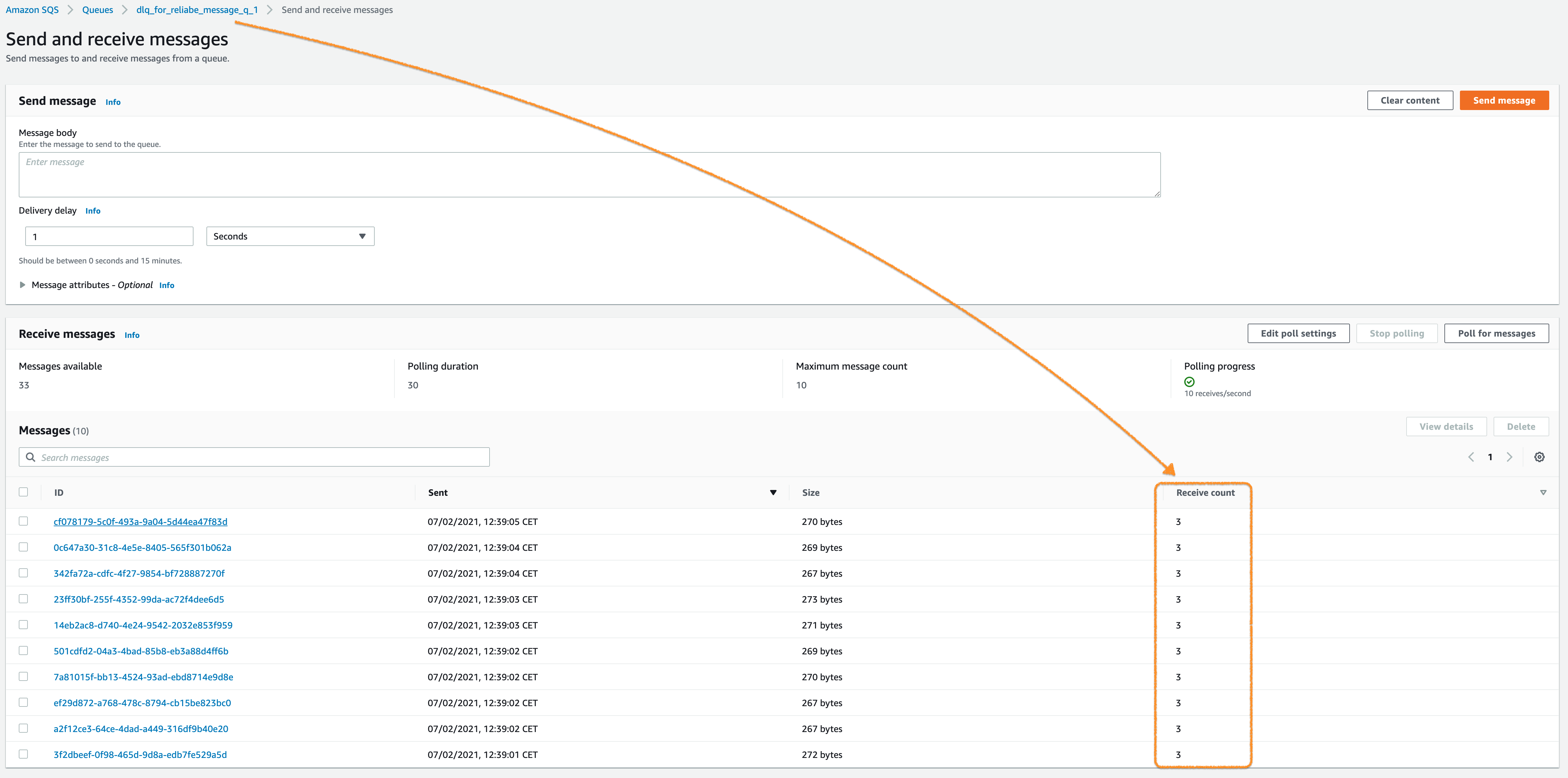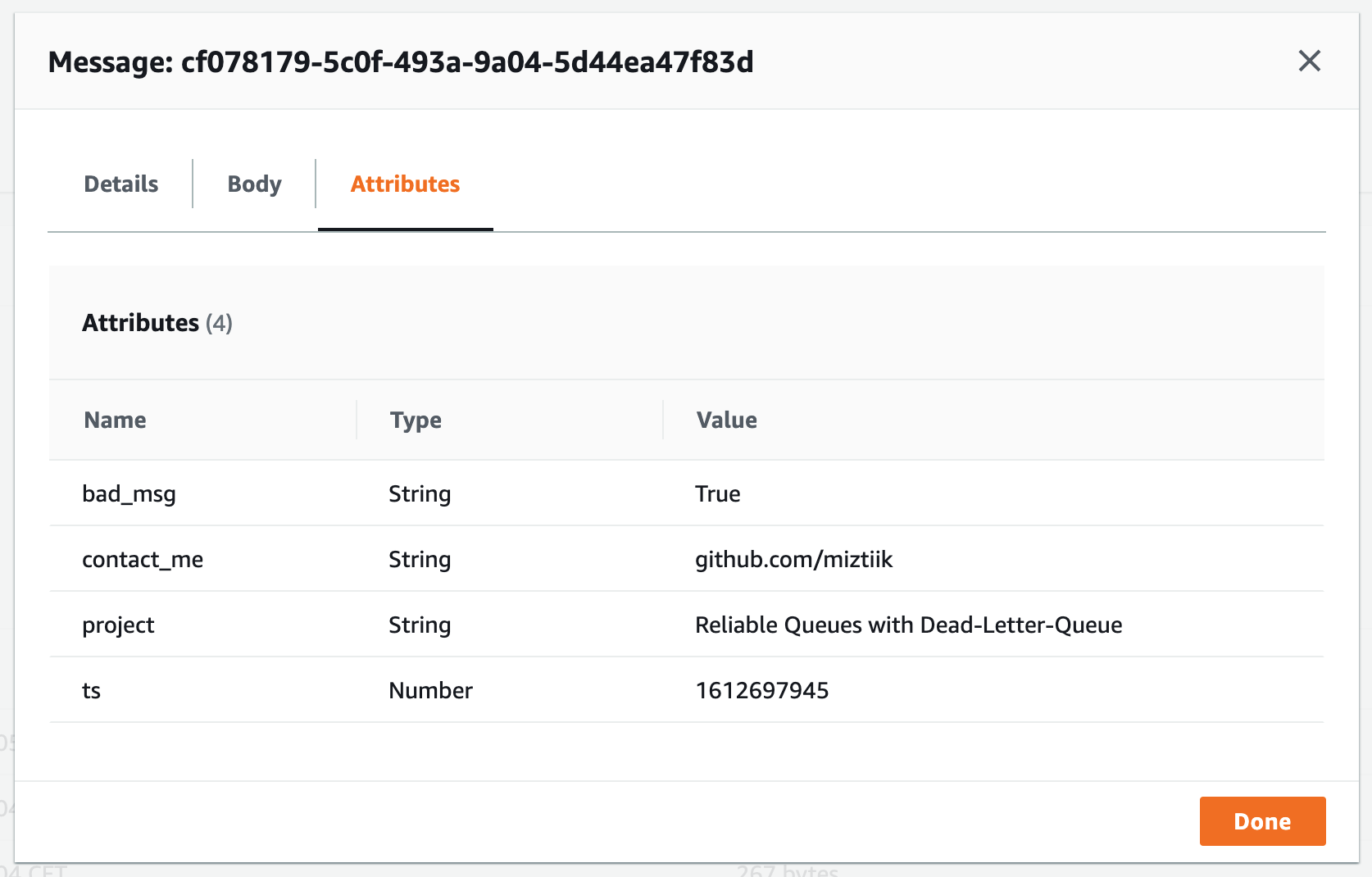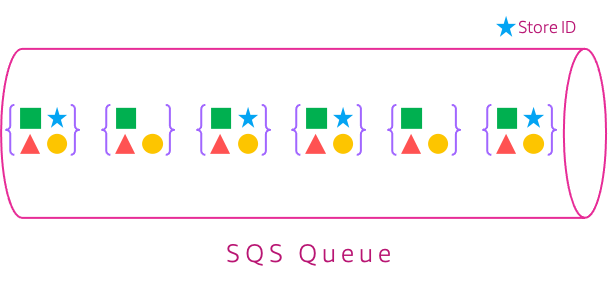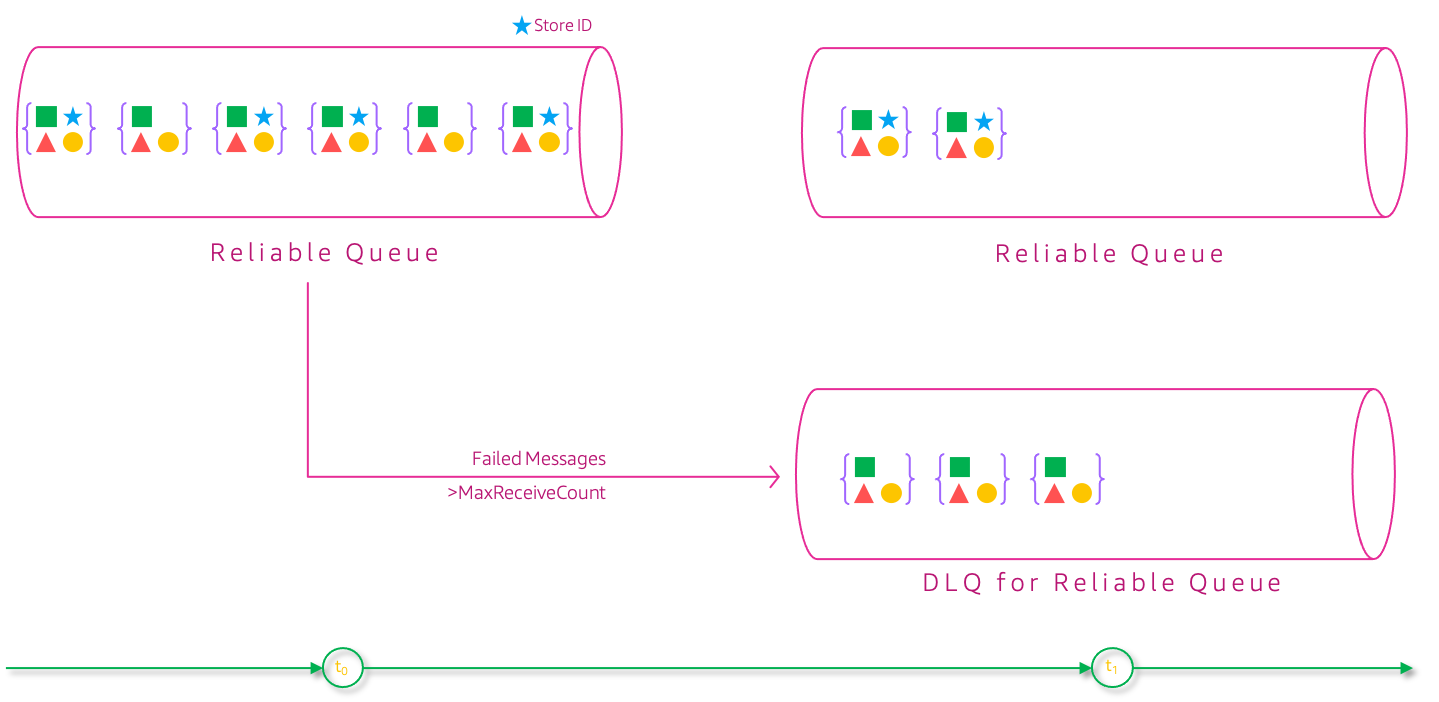Mystique Unicorn App uses message queues to orchestrate their workflows. The messages that are ingested in the queues are produced by stores in multiple geographical locations. For example, if the stores places an order with a particular product ID, but the product ID is unavailable, the app fails. Recently the developers made a change to the app, that allowed them to add the store_id to all incoming messages. When ever this attribute is missing in the payload, that message should not be processed.
As their solutions architect, Can you help them handle these bad/poison-pill messages?
Occasionally messages cannot be processed for a variety of possible issues. In most cases, we do not know the issue. But here we know that when the attribute store_id is missing we should not process the message. When ever we encounter an message without this field then we will need to the move message from the main queue to another special queue: dead-letter queue(DLQ). Currently the queue has messages with and without the attribute.
What we want to achieve is to isolate the messages that do not have store_id attribute to a different queue, so that they can be analyzed later. We can achieve this by using redrive policy.
The redrive policy specifies the source queue, the dead-letter queue, and the conditions under which Amazon SQS moves messages from the former to the latter if the consumer of the source queue fails to process a message a specified number of times. When the
ReceiveCountfor a message exceeds themaxReceiveCountfor a queue, Amazon SQS moves the message to a dead-letter queue (with its original message ID).
For example, if the source queue has a redrive policy with
maxReceiveCountset to5, and the consumer of the source queue receives a message6times without ever deleting it, Amazon SQS moves the message to the dead-letter queue.
Amazon SQS supports DLQs, But Amazon SQS does not create the dead-letter queue automatically. You must first create the queue before using it as a dead-letter queue. Once you have messages in the DLQ you can do the following,
- Configure an alarm[s] for any messages delivered to a DLQ.
- Analyze the contents of messages delivered to a dead-letter queue and logs from your consumer application exceptions
The incoming messages from the stores looks something like this.
{
"msg_body": {
"name": "Shifter",
"dob": "1945-10-17",
"gender": "F",
"ssn_no": "396144610",
"data_share_consent": false,
"evnt_time": "2021-02-06T18:56:59.165483"
},
"msg_attr": {
"project": {
"DataType": "String",
"StringValue": "Reliable Queues with Dead-Letter-Queue"
},
"contact_me": {
"DataType": "String",
"StringValue": "github.com/miztiik"
},
"ts": {
"DataType": "Number",
"StringValue": "1612637819"
},
"store_id": {
"DataType": "Number",
"StringValue": "3"
}
}
}In this demo, We will build an SQS queue called reliable_q and also DLQ that will be dlq_for_reliable_q. We will have lambda functions to produce some messages(to act as stores/producers) and ingest them into our reliable_q. Another lambda to act as a consumer to process these messages. When our consumer lambda encounters any message without store_id attribute, the lambda will throw an exception. The primary queue is configured to process the failed message for 2 times(maxReceiveCount). If it still fails, then the messages are automatically moved to the dlq_for_reliable_q
The final AWS architecture looks something like,

In this article, we will build an architecture, similar to the one shown above. We will start backwards so that all the dependencies are satisfied.
-
This demo, instructions, scripts and cloudformation template is designed to be run in
us-east-1. With few modifications you can try it out in other regions as well(Not covered here).- 🛠 AWS CLI Installed & Configured - Get help here
- 🛠 AWS CDK Installed & Configured - Get help here
- 🛠 Python Packages, Change the below commands to suit your OS, the following is written for amzn linux 2
- Python3 -
yum install -y python3 - Python Pip -
yum install -y python-pip - Virtualenv -
pip3 install virtualenv
- Python3 -
-
-
Get the application code
git clone https://github.com/miztiik/reliable-sqs-with-dlq cd reliable-sqs-with-dlq
-
-
We will use
cdkto make our deployments easier. Lets go ahead and install the necessary components.# You should have npm pre-installed # If you DO NOT have cdk installed npm install -g aws-cdk # Make sure you in root directory python3 -m venv .venv source .venv/bin/activate pip3 install -r requirements.txt
The very first time you deploy an AWS CDK app into an environment (account/region), you’ll need to install a
bootstrap stack, Otherwise just go ahead and deploy usingcdk deploy.cdk bootstrap cdk ls # Follow on screen promptsYou should see an output of the available stacks,
sqs-message-producer-ingestor-stack reliable-sqs-with-dlq-stack
-
Let us walk through each of the stacks,
-
Stack: sqs-message-producer-ingestor-stack
This stack will create the
reliable_qand the DQLdlq_for_reliable_qSQS Queues. An producer lambda function that runs for about5seconds ingesting stream of store messages events for5different stores ranging fromstore_id=1tostore_id=5Initiate the deployment with the following command,
cdk deploy sqs-message-producer-ingestor-stack
After successfully deploying the stack, Check the
Outputssection of the stack. You will find theReliableMessageQueueand the producer lambda functionSqsDataProducer. We will invoke this function later during our testing phase. -
Stack: reliable-sqs-with-dlq-stack
This stack will create the lambda function that will have our
reliable_qas our event source. When ever there is a message in our reliable queue, this function will be invoked.Initiate the deployment with the following command,
cdk deploy reliable-sqs-with-dlq-stack
After successfully deploying the stack, Check the
Outputssection of the stack. You will find themsgConsumerlambda function.
-
-
-
Invoke Producer Lambda: Let us start by invoking the lambda from the producer stack
reliable-sqs-with-dlq-producer-stackusing the AWS Console. If you want to ingest more events, use another browser window and invoke the lambda again.{ "statusCode": 200, "body": "{\"message\": {\"status\": true, \"msg_cnt\": 91, \"bad_msg\": 24}}" }Here in this invocation, We have ingested about
14messages. Within those message, we have3messages does not havestore_ididentified asbad_msg. -
Check Consumer Cloudwatch Logs:
After a couple of minutes, check the consumer cloudwatch logs. Usually the log name should be something like this,
/aws/lambda/reliable_queue_consumer_reliable-sqs-with-dlq-stack. Navigate to the log streamYou should be finding a mix of successful processing like this,
{ "resp": { "status": true, "tot_msgs": 1, "f_msgs": 0, "s_msgs": 1 } }and some
ERRORmessage like this.
[ERROR] Exception: {"missing_store_id":True} Traceback (most recent call last): File "/var/task/index.py", line 111, in lambda_handler m_process_stat = process_msgs(q_url, event["Records"]) File "/var/task/index.py", line 85, in process_msgs raise Exception(err)
Once you have confirmed this, check out the SQS Consume. You will find the same number of failed messages moved to the DLQ
dlq_for_reliable_q.If you go ahead and poll the queue for messages, you will find the receive count is
>2. You can also open one of the messages and look into the attributes

-
-
Here we have demonstrated how to use DLQ for your SQS queues and make sure your messages are processed reliably and move failed messages to a different queue for additional processing. You can extend this by adding a another lambda to process the message from DLQ and move them back to source queue for reprocessing or send an SNS notification to the producers about the failed message.
-
If you want to destroy all the resources created by the stack, Execute the below command to delete the stack, or you can delete the stack from console as well
- Resources created during Deploying The Application
- Delete CloudWatch Lambda LogGroups
- Any other custom resources, you have created for this demo
# Delete from cdk cdk destroy # Follow any on-screen prompts # Delete the CF Stack, If you used cloudformation to deploy the stack. aws cloudformation delete-stack \ --stack-name "MiztiikAutomationStack" \ --region "${AWS_REGION}"
This is not an exhaustive list, please carry out other necessary steps as maybe applicable to your needs.
This repository aims to show how to use DLQs for SQS to new developers, Solution Architects & Ops Engineers in AWS. Based on that knowledge these Udemy course #1, course #2 helps you build complete architecture in AWS.
Thank you for your interest in contributing to our project. Whether it is a bug report, new feature, correction, or additional documentation or solutions, we greatly value feedback and contributions from our community. Start here

Level: 200



